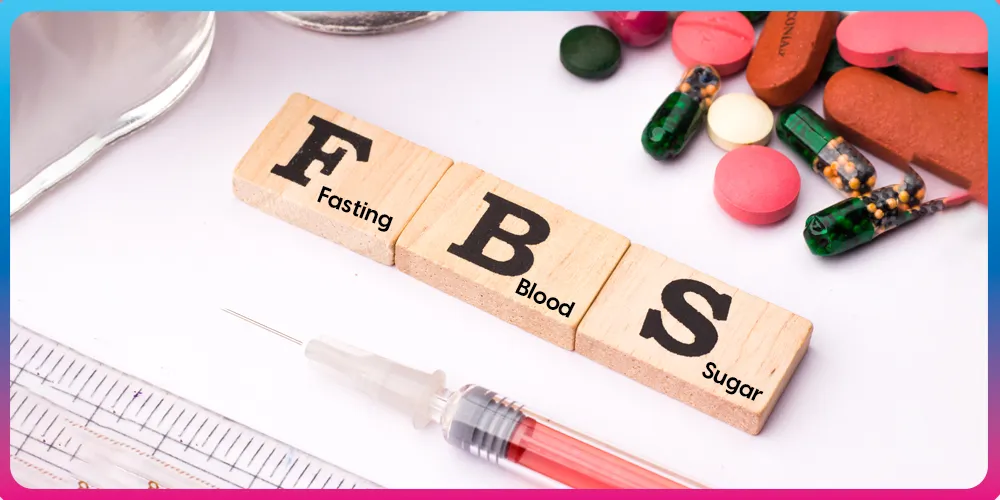Mastering Fasting Blood Sugar: Key to Diabetes Management

Understanding your blood sugar report is crucial to diabetes detection and management. It allows early detection of a rise in blood sugar levels and helps you and your diabetologist track the efficiency of your diabetes management programme.
Self-awareness about the different values in blood sugar test reports can be a game-changer for those with a family history of diabetes or prediabetes.
Today, let us focus on one such vital aspect—blood sugar in fasting.
What is Fasting Blood Sugar Level?
It is the blood sugar level taken early in the morning after an overnight fast of 8-12 hours. The different values of fasting blood sugar according to the stage of diabetes have been stated below.
Normal Values for Blood Sugar in Fasting
According to American Diabetes Association (ADA) standards, medical experts typically recommend the following normal blood sugar range for people who do not have diabetes.
Your diabetologist may advise you to repeat tests to confirm the diagnosis fof diabetes.




Understanding the Concept Behind Testing Fasting Blood Sugar
Blood sugar levels tested in the absence of recent food intake can help practitioners set a baseline for normal blood sugar and spot abnormalities that point to diabetes or prediabetes.
Hormones such as cortisol and growth hormone drive the liver to shift glucose from the stores into the blood in the early morning when your body is fasting for 8 hours or more, providing energy to wake up.
People with diabetes experience insulin-related challenges that are incapable of lowering blood sugar levels. Hence, checking your blood sugar after a night-long fast gives us a real picture of your diabetes status without the influence of food.
Factors Influencing Blood Sugar in Fasting
The three main factors that affect blood sugar during fasting are:
- The type of food you had in your last meal (the evening snack and dinner)
- The proportion of the meal
- How your body has produced and responded to meals
REVERSED Diabetes in 3 months


5.7%
Happy members
EMI
Guarantee
4.8/5
Diabetes Prime Program
Apart from these, it is also influenced by:
- The portion size of your last meal
- The time of your last meal
- Fasting duration
- Sleeping time and quality
- Your meal’s carbohydrate content; if you’ve had sweets and chocolates
- Any alcohol intake in the last evening
- Medications (if you are currently taking any)
Interpreting High-Fasting Blood Sugar Levels
Fasting blood level analysis provides significant information about the body’s ability to regulate sugar levels. High fasting blood sugar levels indicate that the body is having trouble lowering sugar levels. This could be due to insulin resistance, less insulin production, or a combination of the two.
The two effects worth mentioning are:
1. Dawn Effect
In this case, the body doesn’t release enough insulin to combat the morning rise of blood sugar levels caused by cortisol hormones, leading to high FBS. This is very typical of a diabetic.
2. Somogyi Effect
Also known as rebound hyperglycemia, it often occurs when the body releases cortisol to spike blood sugar levels in the blood upon waking up to combat the low blood glucose levels at night. This also shows high FS readings. Commonly, seen in people on insulin who have missed or eaten inadequately for dinner.
Both are typical of diabetes and need immediate attention. The best way to double-check these phenomena is to repeat FBS or use CGM between 3 a.m. and 5 a.m. repeatedly for several days.
Interpreting Low-Fasting Blood Sugar Levels
Excessively low blood sugar levels may indicate that diabetic treatments lower blood sugar levels too much. This could be due to uncoordinated meal timing and insulin injections or taking more insulin than prescribed.
Relating Blood Sugar in Fasting to HbA1c Values
Fasting blood sugar (FBS) is a one-time data. Whereas HbA1c is an average blood sugar reading over three months.
Unlike FBS, HbA1c is unaffected by recent food intake, sleep cycles, medicines, etc. Suppose your test shows that your FBS is high but the HbA1c is within the normal range. Then there could be the following reasons for it:
- The last meal high in carbohydrates or sugar the night before the test
- A short period of fasting
- Insufficient sleep
- Stress, anxiety
How to Keep Your Fasting Blood Sugar Levels in Check
Here are a few ways to keep your FBS from getting deranged:
- Lifestyle modification: Eat healthy and exercise regularly
- Stress management
- Controlling weight
- If you are already diabetic, then take the prescribed medications as directed by your diabetologist
- Regular glucose monitoring
Fittertake
Handling your blood sugar in fasting smartly requires knowledge, guidance, and self-discipline. It will be helpful to reach out for personal help from a diabetes coach to learn more.
Consider consulting our expert diabetologists and coaches onboard Fitterfly’s Diabetes Care Program to learn how to manage the FBS better. You can also directly sign up for our programme if you wish to know more.
To know if you can reverse your diabetes, try our Fitterfly Diabetes Reversal Calculator.
Without much adieu, speak with us by just dialing a missed call at 08068507599, and we will definitely get back to you. Together, let us make the journey towards healing from diabetes more healthy and enjoyable.
This blog provides general information for educational and informational purposes only and shouldn't be seen as professional advice.
Don’t struggle alone & get the expert care you deserve






















